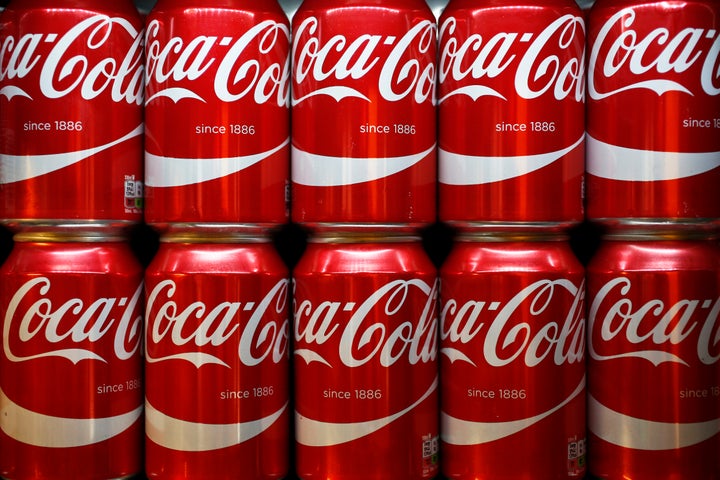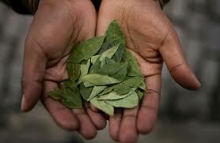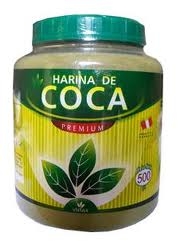Coca Cola Cocaine Traffickers' DEA Protected Monopoly Of Coca Leaf, Destroys Its Health Benefits And Lives Of Native Americans
U.S accepts Colombia's decision to suspend use of weed killer - LA ...
www.latimes.com/world/mexico.../la-fg-colombia-coca-herbicide-20150511-story.ht...
May 11, 2015 - ... of aerial spraying of weed killer on coca crops but that other tools will ... U.S. would not abandon efforts to curb Colombian production of the leaf, ... No final peace deal has been signed, but rebels have agreed to end their ...Spraying Crops, Eradicating People | Cultural Survival
https://www.culturalsurvival.org/publications/.../spraying-crops-eradicating-people
[1] New coca crops planted in more remote areas after the spraying can explain ... is cut to plant coca, which is then sprayed, leading to more forest being cut. ..... and the herbicide found that a number of other factors led to the death or injury, ...Drug Control or Biowarfare? – Mother Jones
www.motherjones.com/environment/2000/05/drug-control-or-biowarfare/
May 3, 2000 - But along with killing coca plants, the toxic fungus may pose serious ... May that US-funded spraying of the herbicide glyphosate (marketed as ...Coca-Cola Has Always Had A Connection To The Cocaine Business ...
https://www.huffingtonpost.com/.../coca-cola-has-always-had-a-connection-to-the-coc...
Sep 1, 2016 - Beginning in the early 1900s, Coca-Cola partnered with a company called MaywoodChemical Works based in Maywood, New Jersey (now the Stepan ... In the 1960s, Coca-Cola, working with its partner, the Stepan .
https://www.huffingtonpost.com/entry/coca-cola-has-always-had-a-connection-to-the-cocaine_us_57c8757ae4b07addc4119330
Coca-Cola Has Always Had A Connection To The Cocaine Business

When news broke yesterday about the discovery of $56 million worth of cocaine at a Coca-Cola plant in France, the press was all abuzz. But as it turns out, this Cocaine-Cola connection is not entirely new; Coca-Cola has been intimately linked to domestic manufacture of cocaine in the United States for years.
A little glimpse into Coke’s history reveals all.
Yes, most people know that Coca-Cola’s first president Asa Candler became concerned about cocaine in the early 1900s and decided to remove any trace of the drug in the company’s famous drink, but few people know that Coke continued to use what is called “decocainized coca leaf extract” in its signature beverage. In company ledgers, this―mixed with kola nut powder― is what is known as Merchandise #5, one of the “secret ingredients.”
Here’s how the process works. Beginning in the early 1900s, Coca-Cola partnered with a company called Maywood Chemical Works based in Maywood, New Jersey (now the Stepan Company) to import coca leaves (which contain small quantities of the alkaloid found in purified cocaine powder) from Peru for Coca-Cola. The company removed the cocaine alkaloid from these leaves and then sold Coca-Cola the leftover extract. As per the cocaine, Maywood sold it under close federal supervision for approved medical uses.
Federal law sanctioned this practice. Legislators wrote a special exemption into the Harrison Narcotics Act of 1914, the Jones-Miller Act of 1922, and subsequent counternarcotics legislation that allowed “decocainized coca leaves or preparations therefrom” to be sold in the United States. Some lawmakers called this clause the “Coca-Cola joker” because it was clearly designed to protect Coke’s secretive coca business.
Over time, Coke’s demand for coca leaves grew so great that legislation had to be passed to allow leaves to come into the country beyond what was needed for the manufacture of cocaine for medicinal purposes. These laws specified that alkaloids extracted from these coca leaves had to be destroyed with federal officials bearing witness.
All was well for Coke for many years under this arrangement, but in the 1960s, the company got a crazy idea: why not grow coca leaves secretly in the United States? That way the company would have a domestic source of supply.
It may sound outlandish, but that’s exactly what happened. In the 1960s, Coca-Cola, working with its partner, the Stepan Company, gained federal approval to begin a secret coca cultivation operation in Hawaii called the “Alakea” project. University of Hawaii scientists agreed to participate in the project but were prohibited from publishing any reports about their work because Coke did not want the public to know about its relationship to these coca leaves. ........................
http://a-healthy-self.com/2011/05/07/benefits-of-coca-leaf/
Benefits of Coca Leaf
When you ask a local how to treat the altitude sickness they would immediately say to you “Mate de Coca” otherwise Coca Tea. Drinking Mate of Coca does work but my experience is that it takes a fair amount of tea in order to work effectively. From my point of view the main reason was that I was drinking the commercial version and like all other commercial teas in Bolivia it was quite weak in comparison to using actual leaf. The consequence of drinking all of this tea was my bladder could not take and the combination of altitude and needing to find a toilet was not a good at all. Luckily for me my partner is a Homeopath and got us to take a Homoeopathic version of Coca called Alturan (the Bolivian version) and it worked a treat and that saved my bladder – phew!!!
A very important study published by Harvard University in 1975 (Duke, J., D. Aulik and T. Plowman, Nutritional Value of Coca) found the coca leaf has a large amount of nutrients and that each 100 grams of leaf coca contain Calcium 1749 (mg), Phosphor 637 (mg), Vitamin A 10000 (iu) which is enough to satisfy the nutritional needs of an adult for 24 hours.
According to research, the chemical composition of coca leaves is more complete and rich in calories, proteins, fats, carbohydrates, fibre, ash, minerals (calcium, phosphorous, iron, potassium, magnesium, sodium, ascorbic acid, etc.) and vitamins A, C and E than other food plants and infusions in common use such as coffee, tea, chamomile, etc. Thanks to this research, it is nowadays recognized that the coca leaf contains more proteins (19.9 per cent) than meat (19.4 per cent) and far more calcium (2,191 per cent) than condensed milk, and that it is richer in vitamin B-1 (276 per cent) than fresh carrots.
According to research, the chemical composition of coca leaves is more complete and rich in calories, proteins, fats, carbohydrates, fibre, ash, minerals (calcium, phosphorous, iron, potassium, magnesium, sodium, ascorbic acid, etc.) and vitamins A, C and E than other food plants and infusions in common use such as coffee, tea, chamomile, etc. Thanks to this research, it is nowadays recognized that the coca leaf contains more proteins (19.9 per cent) than meat (19.4 per cent) and far more calcium (2,191 per cent) than condensed milk, and that it is richer in vitamin B-1 (276 per cent) than fresh carrots.
| COCA | NUTRIENTS | |
Calories Proteins Fats Carbohydrates Calcium (mg) Phosphor (mg) Iron (mg) Vitamin A (iu) Vitamin B1 (mg) Vitamin PP (mg) Vitamin C (mg) Vitamin B2 (mg) | 305 (mg) 19.9 3.3 44.3 1749 637 26.8 10000 0.58 3.7 1.4 1.73 | 279 (mg) 11.4 7.9 37.9 99 270 3.6 35 0.58 2.2 13.0 0.18 |
Nutritionist Maritza Vera worked with patients in a Peruvian hospital to cure themselves of diverse diseases like chronic anemia, depression, osteoporosis and leukemia. They achieved this by adding “flour of coca” (toasted and ground coca leaf) to their foods. The coca contains “reserpina” that regulates the pressure and forms osteoblasts which helps patients with osteoporosis, according Maritza Vera.
The innocuous nature of traditional use of coca leaves and the benefits for human health were proven with scientific rigour by the most extensive study of coca ever done. This research was carried out between 1991 and 1995 by the World Health Organisation (WHO). The concentration of cocaine alkaloid in the leaf, is very low, and therefore, ingested in natural form, it does not produce serious toxicity nor it generates dependency.
On our return we brought back a couple of bags of harina de coca and some coca tea for our own use and had no problems bringing it in through customs, however, I would suggest that you check with you local customs office first as the regulation do vary between countries. We have used as a tonic not only for ourselves but when the kids have been sick and we found that our energies were significantly boosted.
As part of our research we also started to find products now available in other countries which are coca based such as herbal liqueur called “Agwa de Bolivia” grown in Bolivia and de-cocainized in Amsterdam. Now Bolivia is starting to make their own coca leaf soft drink called Coca Colla, ironically the same ingredient that Coca Cola started to use in their own drink. Since then we found a whole range of products including lozenges, some which are suitable for kids and some strictly for adults; toothpaste; hair products; rubbing creams, pastries, etc which is available over the internet.
Whilst in Bolivia we were fortunate enough to spend time with the Coca Museum in La Paz curator and learned a little of the history of the coca plant and it”s use in traditional cultures. The coca history is as rich and varied as the properties of the plant and its uses. You can see the interview in our travel blogas we broken it into several parts as it is an hour long.
There you have it – who would it thought that coca leaf which has been associated with cocaine for so long would have some may benefits to once health.


No comments:
Post a Comment